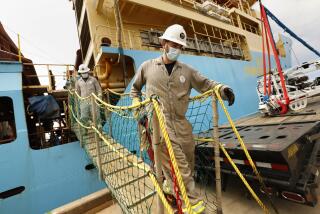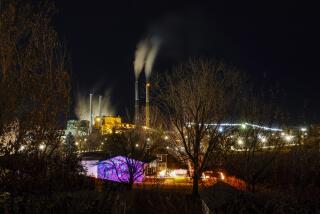Alaska Natives try to halt proposed Pebble Mine
- Share via
SEATTLE — It has always been a match made in peril: One of the biggest copper and gold mines in the world perched in the watershed above Bristol Bay, Alaska -- the last, best refuge for millions of Pacific wild salmon.
The proposed Pebble Mine would dwarf all the others operating in the Alaskan wilderness and generate up to 9 billion tons of ore, most of which would have to be sifted and disposed of near the ponds and streams that feed into Bristol Bay.
It also would generate hundreds of jobs in troubled southwestern Alaska, and as much as $300-billion worth of copper and gold.
In an attempt to head off the project before it gets too big to stop, a coalition of Alaska Native village corporations and others filed suit this week in Anchorage, charging that the state was violating its Constitution by allowing drilling and other exploration to proceed without full environmental review.
The mine would cover 15 square miles, with a 1,600-foot-deep open pit stretching across two square miles. Early development proposals have called for holding the hazardous tailing behind massive dams -- one 740 feet high, the other 450 feet high. The exact plans won’t be known until 2010 or 2011, when Pebble Partnership submits its development permit applications to the state.
Conservationists worry that the millions of dollars spent on exploration while officials conduct public hearings and await the environmental impact statement will give the project political momentum that even Alaska’s powerful fishing industry would find hard to fight.
The lawsuit invoked an article of the Alaska Constitution that requires hearings and analyses to determine whether state-owned natural resources are being managed for the common public good. Specifically, the suit argued that Alaska should conduct studies to determine whether exploration at the mine was affecting other users of public land, water, fish and wildlife.
“This kind of activity is being treated . . . as if there’s some guy out there with a mule, a pick ax and a shovel turning over a little bit of rock and looking for a nugget. But this is in essence industrial-scale activity,” Steve Cotton, executive director of the public interest law firm Trustees for Alaska, said at a news conference in Anchorage.
Representatives of Nunamta Aulukestai, a coalition of eight native village corporations that filed the lawsuit, said they already were seeing effects from the exploration. Fewer caribou linger in the area, they said in court papers, and waste from exploratory drilling has trickled into streams and ponds.
“What we would like to see right now is for everyone to take a step back and look at all the potential negative impacts associated with a development this large in an area that’s incredibly sensitive and extremely important to a lot of people in this state,” said Tim Bristol, director of Trout Unlimited in Alaska, which has opposed the mine but is not a plaintiff in the lawsuit.
“You have a giant open pit proposed; you’re going to have billions of tons of waste rock, 100 miles of access road; a deep-water port is going to have to be constructed; there’s going to have to be a source of power, incredible amounts of water to charge the system and store the waste; and you have to think about how to treat that waste in perpetuity . . . in a region that right now is sort of this wild salmon wilderness,” Bristol said.
Trout Unlimited and other conservationists back legislation that would require a separate set of reviews for the Pebble Mine, given its proximity to Bristol Bay, which generates a third of the state’s commercial fishing revenue. The state Legislature won’t have a chance to act on that until it re-convenes in January.
State officials have said that plenty of studies would be done once Pebble applies for its development permits. At the moment, they added, exploration is going on at hundreds of mining claims, large and small, across the state, and Alaska law does not require formal studies or public hearings.
“There are 400 to 500 of these in place, statewide, at any one time,” said Tom Crafford, mining coordinator at the Alaska Department of Natural Resources. “Absolutely, once a project applies for development permits, then that triggers a whole host of permit requirements, public notice requirements, comment periods, both state and federal.”
Pebble Partnership Chief Executive John Shively said there already has been full inspection by state and federal agencies, including the state Department of Fish and Game and the federal Environmental Protection Agency. “So it’s not like there’s no oversight,” he told KTUU-TV in Anchorage, “or that the public doesn’t have the ability to look at what our program is and to go tell the agencies what they think about it.”
--
Read Greenspace, The Times’ blog on environmental issues, at latimes.com/greenspace.
More to Read
Sign up for Essential California
The most important California stories and recommendations in your inbox every morning.
You may occasionally receive promotional content from the Los Angeles Times.










